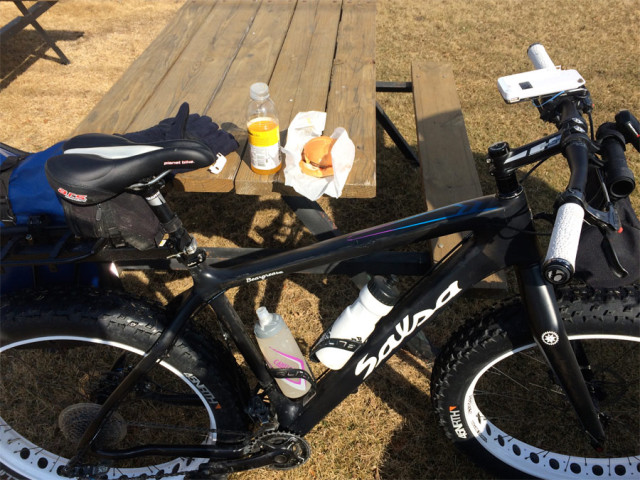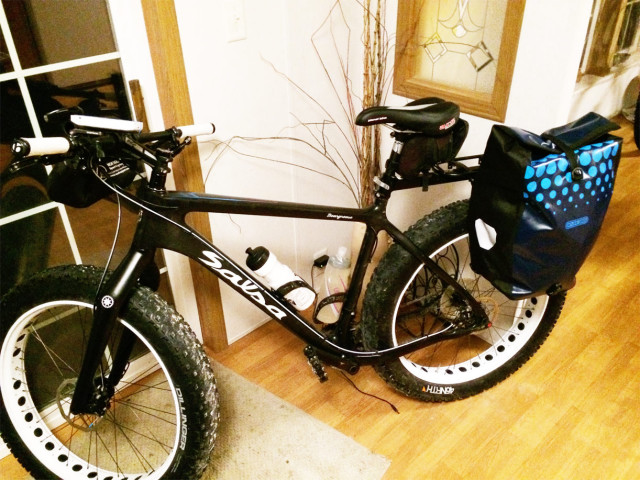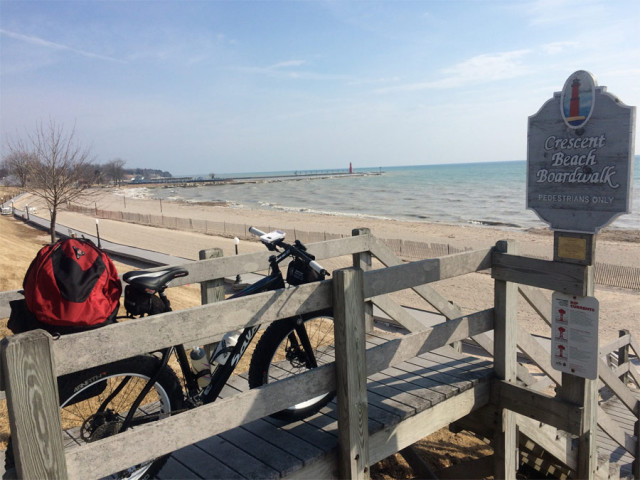Midwest USA, Trip Reports » Riding a Fat Bike Year-Round – First Bikepacking Report
I’m involved on various forums and Facebook groups and it seems the interest in Fat Biking is gaining momentum. For many in the community, Fat Tire bikes are no longer considered just ‘snow bikes’. And why should they be? Sure, that large 4″ tire has a fair amount of rolling resistance, and if you go for one of the heavier bikes it’s sure to give you a workout, but fat bikes are versatile, comfortable, durable, and, as we all like to point out ad nauseum, they’re a lot of fun too!
Last year, towards the end of my first season of frequent cycling, I set about deciding what bikes to own in 2015. My only steed, a GT Karakoram 29er, had taken me everywhere over the course of the year. It had doubled as a road bike, a gravel bike, a trail bike, a singletrack machine, and…..as a touring rig.
Hardly ideal, but as I said, this was my first year of cycling so it was very much a moving target, a fluid situation. But I was going to need a new ‘do it all’ bike for the 2015 season, I just wasn’t sure what to buy. The bikes which were on my radar, and still are to varying degrees, included the Cannondale CAADX, the Salsa Vaya, the Trek 920 and the Salsa Fargo.
In October 2014 I pretty much decided that I wanted to try and stay fit through the winter and the best way to do that was to go out and buy a fat bike. So I did, a Charge Cooker Maxi2, which I replaced in February with a Salsa Beargrease Carbon [reviewed at the link].
I really, really like the Beargrease, it’s head and shoulders above the old Charge Maxi I owned previously.
So after the usual four months of Wisconsin winter, I emerged in Mid-March wondering two things –
1 – How was my fitness/endurance after 4 months of fat biking?
2 – Am I any closer to deciding on a bike for 2015?
The fitness angle is an interesting one. In 2014 I started the year by losing a lot of weight and basically getting somewhat fit. I’m an older guy in my early 50’s, and I’ve never been an athletic type, so ‘fit’ for me meant being able to run up a few stairs without getting breathless.
Slowly I built up my fitness over the course of the riding season. By September I was ready to have a crack at my first Century ride, which I completed on my 29er in a little over 7 hours. A week later I did my second and last Century of the season.
So I was building fitness and riding longer distances, but when winter came along, and the fat bike appeared on the scene, my riding distances and duration/time in the saddle, tapered off a lot. I couldn’t stand to be out in the cold for more than a couple hours, so my workouts were shorter, but of high intensity.
So I was curious how my fitness levels were now, in March 2015, compared with how they had been at the close of Fall.
Also, I needed to get serious about picking a bike. I’d procrastinated towards the end of the year and now spring was almost upon us I needed to make a decision pretty soon.
But then, I started to read all of the forum ‘chatter’ about people running fat bikes year round. People were racing fat tire bikes in snow, on gravel, on dirt etc. People were riding fat tire bikes recreationally on the beach, on gravel, even on asphalt. And people were selling off their mountain bikes and replacing them with fat bikes. Heck, people were even bikepacking on fat bikes!
Wow.
Perhaps I have everything I need from a bike right here with the Salsa Beargrease?
There was only one way to find out.
Taking the Beargrease on a road-trip
I’d bought a few things at the various online sales over the winter and I was already itching to give them a try.
I’d picked up a seatpost pannier rack from Amazon.com It was going to need to be modified to run panniers on both sides of the rack and clear the 4″ tire, but it worked well with a single pannier.
I picked up a pair of Ortlieb Back Roller classics, a handlebar extender and a few other bits and pieces.
So on the eve of Friday the 13th, I booked a hotel room some 80 miles or so away from my home, and packed up the Beargrease ready for her first big trip!
On Friday the 13th I rolled out into a cold and windy Wisconsin morning, filled with excitement and trepidation in equal measures.
The weather forecast had been fairly accurate for once – a cold, brisk 30mph wind blowing from the South East, pretty much a headwind the entire route. Temps were going to be colder by the Lake (Michigan), my intended route – 25 degrees rising to 35 later in the day. Skies were overcast with some sun poking through here and there.
The trip was awesome.
Sure, the 4″ tires make pedaling quite hard, but the bike is comfortable to ride for long distances with it’s relaxed and upright riding position.
Carrying the gear on the single pannier mount, a couple of toolkits (seatpost mounted and another under the bars) and a few items of light clothing in a backpack, proved completely hassle free.
I cycled south from Egg Harbor WI, through Sturgeon Bay then down the lakeside for my first brief rest-stop in Algoma WI
Riding on from Algoma and down to Kewaunee, I took a few minutes off to enjoy a good cheeseburger from a Citgo Gas station!
 I made the hotel before 4pm. Approximately 79 miles covered on the first day.
I made the hotel before 4pm. Approximately 79 miles covered on the first day.
I felt good, my energy levels were very good and my leg muscles were doing just fine. My rolling average was only 10 mph but I attribute that pace as much to the hard headwind as I do to the 4″ tires.
But I was in good shape – no backache, no neck pain, no muscle soreness. It was a good first day in the saddle.
On Saturday morning I was expecting to catch a ride home on the tailwind so I started the day off quite late, around 8am.
To my amazement the wind had pulled the old switcheroo on me and had shifted almost 180 degrees and was now blowing hard out of the North West. That pretty much meant another day riding into a 25mph headwind.
Saturday’s riding wasn’t very pleasant. I grew tired of the strong winds quickly and tried to reroute onto a couple of gravel trails which I knew would offer some shelter from the wind.
I rode part of the Devils River State Trail and later on in the ride, the Ahnapee State Trail – both packed gravel with some wet/muddy sections of dirt here and there.
The whole trip home was a slog. With the reroutes it added distance and I made it home with 90.13 miles on the clock.
It was late when I arrived home, after 8pm, and I was pretty tired.
170 miles over two days was a lot for my first ride of the season, but it felt good having completed it.
Conclusion
Yes, it’s possible to tour on asphalt on a Fat Tire bike. The experience could certainly be improved by adding a 29er wheelset or a 29+ wheelset, but then it wouldn’t really be a fat tire bike, would it?
I think it’s viable for me, given that I probably won’t do too many road trips of this magnitude. I’ll probably camp 3 or 4 times over the course of the year ahead and perhaps limit my daily mileage to a more sensible 60 or so. For which, the Salsa Beargrease will work just fine.
That’s not to say I wont add another bike to my collection before long 🙂


Nice article. I have a Pugsley Opps. I made another wheelset for it with surly rabbit hole rims and surly knards 26 x 3. Essentially a 26+ set up. Significantly made the bike lighter as well. It is awesome for trails and commuting on. Rolls much faster and corners much better. I love it so much I ride it year round now and also use it for bikepacking, commuting, gravel riding and single track.
Thanks for the post. I am in the process, a slow process, of building up a Salsa Mukluk 2 frameset as a bikepacking bike to go bikepacking here in Western Australia. I prefer to chase the dirt etc and my Surly Long Haul Trucker is limiting and those corrugations are a killer on this bike.
I must admit in the last couple of days I was wondering if I shouldn’t have gone a Salsa Fargo but now that I read your post I am back to being happy with my decision to go with the Mukluk 🙂
@Jim – that sounds like a really nice setup. I’ll probably do something similar with my Beargrease, though maybe I’ll go a little narrower than the Knards.
@ Andrew – I can’t imagine having access to so much rough terrain and unexplored territory, that must be awesome. I can’t avoid riding mostly asphalt in my part of the world, if I want to get anywhere.
So it sounds like your Mukluk is the perfect bike for your location! I’ve ridden the Fargo, very briefly and you’re certainly not missing anything with the Mukluk. Great bike.
I’m planning a three day trip fairly soon which will be my first multi-day bike trip. I’ve a Giant Anthem and bought a seatpost mounted rack for the trip, but when i hang the pannier on it – gravity means its rested againt the rear wheel.
How did you stop your pannier contacting with your back wheel?
Hello Captainstu!
There’s a minimum clearance recommended by the manufacturer, so it could be that yours is too close. The geo of my Salsa Beargrease is such that the seatpost is well extended and there’s ample clearance. Also, when I clamp mine tightly on the post, it doesn’t sag more than around 1/4″ when I attach the pannier. If yours is sagging too much then can you attach it differently or more tightly? If it’s well constructed there really shouldn’t be any sag if you keep the a=bag weight within manufacturers spec.
My biggest concern with this type of mount is dropping the bike and having the pannier bag go into the spokes. There’s nothing to stop mine deflecting sideways, but deflecting down, under weight, hasn’t been an issue.
So far it has worked well for me, though I also bought a Revelate Designs Viscacha, which might be an option for you too?
It isn’t without some issues though, as I covered in a review here
Good luck.
Hey thanks for the speedy response.
I didn’t explain too well – the rack itself is clamped tightly and doesn’t sag much at all – it was the sideways deflection of the pannier I meant was the issue.
When i hung a pannier lightly loaded on the rack, it immediately deflected sideways against the wheel.
Its a very cheap pannier which doesn’t have much rigidity, and it just has two plastic clips which clips onto the rail on the rack.
How does your pannier not delfect against the wheel?
Ah OK, I’m with you now. Yes I had that problem too. First off the rack I bought wasn’t designed for a fat tire bike specifically. I’m pretty sure it said it could be used on wide-tire bikes but it wasn’t specific about clearing the 4″ tires.
On the ride report above it was easy, I wasn’t camping I was just doing a hotel overnighter so I only used one pannier bag. I simply turned the rack a few degrees sideways then clamped it, so there was plenty of clearance.
On subsequent trips I’ve had to do a couple tweaks to accommodate both bags. The side rails on the rack I have are detachable, so I just fitted 1/4″ spacers between the side rails and the mounting points and used longer screws. I just used regular washers as spacers. I also bent the side rails outwards a little bit by kinking the rails at the top near the mounting points. They’re pretty sturdy but just a 1/4″ or so of bend is enough. Now when I mount full bags they sit clear on both sides of the wheel, but there isn’t much clearance, maybe 1/2″ on each side.
It works fine so long as the bags aren’t overloaded. Is it ideal? Probably not. There are actually kits you can buy that will turn the seatpost rack into a 3-point supported rack. Or if you don’t have eyelets for mounting a supported rack there are ways around it.
It might be worth looking at these if you’re using heavier bags and if your rack isn’t very rigid to begin with.
Here’s some options
Here